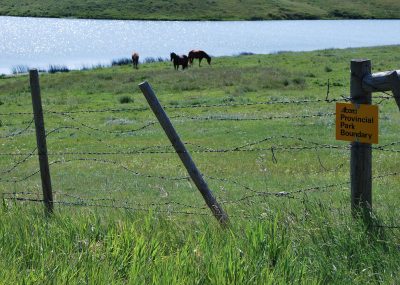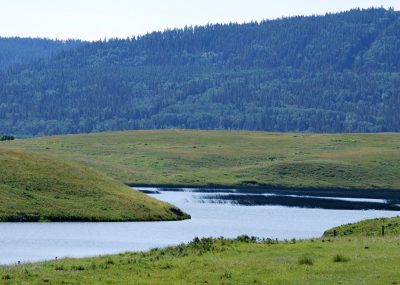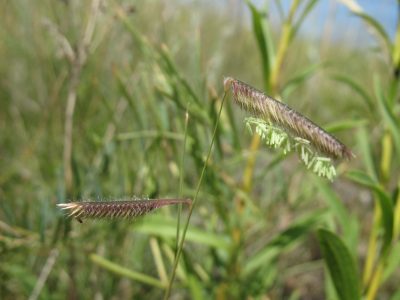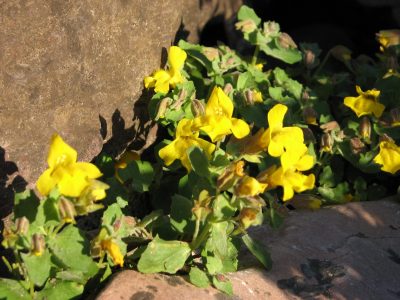
Rising out of the prairies, the interprovincial Cypress Hills boast the highest elevation between the Rocky Mountains and the Torngat Mountains of Labrador
- •
- •
- •
AWA’s vision for Cypress Hills Provincial Park is that industrial development is minimized to preserve the area’s unique natural heritage and remaining intact native grasslands. Energy development, including wind energy, is inappropriate on public lands within native grasslands and ecologically significant areas.
- Introduction
- Features
- Concerns
- History
- Archive
- Other Areas
 |
 |
Once a nunatak, the Cypress Hills now rise 600 metres above the Western Canadian prairies. PHOTO © K. MIHALCHEON |
The 1,996 km2 of the Cypress Hills Area of Concern is located in the southeastern corner of Alberta, straddling the Alberta-Saskatchewan border. The unique geography of the Hills as a high point among the low-lying Canadian prairie has produced rich cultural and ecological heritage. Cypress Hills Provincial Park, alone, hosts 217 species of bird, 38 mammals, five reptiles and four amphibians, among which are rare and endangered species; and the quiet hills, slopes and green coulees surrounding the Provincial Park have been home to families, ranchers and farmers over many generations. Impressive views of relatively undisturbed landscape spread from the highest points looking to the north. To the south, the gentle slopes give way to the Sweetgrass Hills in the distance.
Status
Within Alberta, 403.2 km2 of the Cypress Hills are protected as the Cypress Hills Provincial Park (400 km2) and Red Rock Coulee Natural Area (3.2 km2). The Cypress Hills Provincial Park, the Alberta arm of the Cypress Hills Interprovincial Park, contributes to the protection of the Cypress plateau. Surrounding the Provincial Park is a 278 km2 protective fringe.
Outside of these protections, the remainder of the Cypress Hills consist of private and public lands within the White Area of Alberta, primarily managed for agricultural development.
Management
Protected Areas
The protected areas of the Cypress Hills, the Cypress Hills Provincial Park and Red Rock Coulee Natural Area, are managed under the Provincial Parks Act and Wilderness Act, Ecological Reserves, Natural Areas and Heritage Rangelands Act (WAERNAHR), respectively. The Provincial Park also takes direction from the Cypress Hills Provincial Park Management Plan, established in 2011.
Public lands
A 278 km2 buffer area surrounds the Albertan side of the Cypress Hills Provincial Park, designated as ‘the Fringe’ and managed under an Area Structure Plan (ASP). The goal of the ASP is: “To provide an opportunity for development in the Cypress Fringe plan area in a manner that respects the values that created Cypress Hills Park and respects the heritage and ecological landscape of the area.” Public lands are also managed under a number of provincial acts and regulations, primarily directed by the Public Lands Act.
Area
The 1,996 km2 Cypress Hills Area of Concern is located in the southeastern corner of Alberta, straddling the Alberta-Saskatchewan border. The unique geography of the hills – as a high point among the low-lying Canadian prairie – has produced rich cultural and ecological heritage. The Cypress Hills are located south of the TransCanada Highway, along the southernmost stretch of the Buffalo Trail (Highway 41). The town of Elkwater, bordering Elkwater Lake, is located within the Cypress Hills Provincial Park.
 The Cypress Hills Area of Concern. MAP © AWA: JPG | PDF
The Cypress Hills Area of Concern. MAP © AWA: JPG | PDF
Watershed
The Cypress Hills contribute to the South Saskatchewan and Milk River Watersheds; two major watersheds for freshwater provision in the Canadian prairies. Ross and McAlpine Creek drain into the South Saskatchewan, and Battle, Graburn, Nine Mile, Willow, Stoney and Storm Creek drain into the Milk River.
The sensitive nature of the water basins in the Cypress Hills, including Elkwater Lake, has led to the creation of agricultural water co-op and moratoria on future water licenses to effectively manage water use within the area.
The Cypress Hills were formed as a result of sedimentary deposition over millions of years, followed by a strong resistance to the glacial erosion that flattened the surrounding prairies. This unique resistance to glacial processes allowed the Cypress Hills to stand as a ‘nunatak’ – a tall ice-free structure amidst a glacial sheet – and allows Cypress Hills to stand up to 600 m higher than the prairies today.
The Hills are composed of a thick layer of conglomerate deposited, exposed by meltwater channels along their northern and western edges, also accompanied by glacial debris at the northern edge. Winds during deglaciation also brought moderate and fine-textured loess sediment overtop of the conglomerate.
Environmentally Significant Areas
The Cypress Hills hold national environmental significance due to their high cultural value and the unique habitat they provide for many rare or endangered flora and fauna. The high ecological value is derived from the Cypress Hills’ anomalous physiography, as they tower up to 600 m over the surrounding prairies.
 Environmentally Significant Areas of Cypress Hills. MAP © AWA: JPG | PDF
Environmentally Significant Areas of Cypress Hills. MAP © AWA: JPG | PDF
Natural Regions
The Cypress Hills fall within a unique stretch of the Rocky Mountains Natural Region, as well as within the Grasslands Natural Region. Natural Subregions within the area include Montane, Dry Mixedgrass and Mixedgrass.
 Natural Regions of Cypress Hills. MAP © AWA: JPG | PDF
Natural Regions of Cypress Hills. MAP © AWA: JPG | PDF
Vegetation
Montane: lodgepole pine, pinesap, white spruce, trembling aspen, red-osier, dogwood, bunchberry, stiff clubmoss, western Canada violet
Mixedgrass prairie: western porcupine grass, spear grass, June grass, green needlegrass, blue grama, early yellow locoweed, golden bean, wild bergamot, pasture sage
Rare species: Spike redtop, Eaton’s aster, western grape fern, Back’s sedge, broad-scaled sedge, Rocky mountain sedge, waterpod, goosefoot, dwarf fleabane, few-flowered rush, flowering quillwort, biscuit root, smooth sweet cicely, low yellow evening-primrose, blunt-leaved yellow cress, yellow monkeyflower
Wildlife
The Cypress Hills support a broad variety of fauna, including endangered and rare species; faunal variety includes 217 bird species, 38 mammals, five reptiles and four amphibian species. Of the extensive bird populations, the Cypress Hills boast dusky flycatcher, orange-crowned warbler, red-naped sapsucker, hermit thrush, chipping sparrow, lazuli bunting, sharp-tailed grouse, and notably, Sprague’s pipit and the common poorwill.
The region holds particular significance for its large mammal species, given that the unique habitat has provided an important vegetative resource. Some mammals, such as elk and moose, were extirpated from the Cypress Hills Provincial Park and have since been reintroduced. The presence of the elk population has caused some controversy within the Provincial Park, as their grazing is in conflict with some priorities in the surrounding agricultural community. Predators, such as cougars, also have a major presence in the Hills. Common small mammals include porcupine, voles, shrews, cottontail rabbit, raccoons, coyotes, red fox, bobcat, striped skunk, and American badger.
Some of the reptile and amphibian species inhabiting the Hills and surrounding wetlands include the red-sided garter snake, bullsnake, painted turtle, wood frog, northern leopard frog, boreal chorus frog and northern leopard frog.
Cultural
Indigenous Peoples have used and resided among the Cypress Hills for more than 8,000 years.
The Cypress Hills hold particular cultural significance for Indigenous groups, including Peoples of the Métis and the Blackfoot Confederacy (Niitsitapi) communities. The area contains a number of culturally significant sites, including the South Battle creek Site, Stampede Site, a number of important burial sites, and the notably, the Cypress Hills Massacre.
Activities
The Cypress Hills Provincial Park has a number of developed areas that offer comfort camping, golfing, and sightseeing by vehicle. Low-intensity activities in the park also include biking, hiking along 50 km of trails, horseback riding, swimming, fishing and hunting. Red Rock Coulee Natural Area also facilitates geocaching, front country hiking and hunting. Off-highway vehicle (OHV) use is banned from both protected areas.
Wind farms
While AWA supports green energy alternatives and is not opposed to wind energy, we assert that wind farms are an industrial land-use and not appropriate in endangered native prairie grasslands or environmentally significant areas. The development of wind-based Power Plants within the ‘Fringe’ of the Cypress Hills threatens the five percent of natural grasslands that remain in Alberta. The current Area Structure Plan (ASP) prioritizes the conservation of high quality native rangelands and the minimization of roads and development. While wind farms would be seemingly in conflict with the ASP, there are not any additional specifications to address wind farm development, and are “compatible” with the plan.
AWA reiterates that the land-conversion necessary to develop the wind farms and their associated access roads involves the further removal of native prairies. These disturbances fragment sensitive grasslands and ushers in invasive species that can out compete the native flora. Native fescue grasslands have never been successfully reclaimed. Once they are destroyed they are gone forever.
Cypress Hills Fringe Area Structure Plan, May 2003 and Bylaw Amendment for Wind Energy Facilities, March 2005.
2021
AWA continues to oppose development in the Cypress Hills Fringe Area, initially preserving a buffer zone around Cypress Hills Interprovincial Park, and spoke out against the proposed wind farms. Regrettably, the proposals were approved.
2016
The Alberta NDP government invests $239 million in provincial parks upgrades over the next 5 years, with Cypress Hills included for asphalt paving, retaining lake wall upgrade at Reesor Lake, and Comfort Camping in 2016-17, and boardwalk restoration in the next 2-5 years.
2014
NaturEner receives approval from the Alberta Utilities Commission (AUC) to develop the Wild Rose 2 Power Plant.
2013
Having received approval for 70 wind turbines in its Wild Rose 1 wind farm, NaturEner continues its application for 63 wind turbines in Wild Rose 2. Pre-construction for Wild Rose 1 is scheduled for the spring of 2014 with the turbines possibly in place by the fall.
Wild Rose 2 could begin construction in 2015.
2012
Cougars, which are believed to have begun recolonizing Cypress Hills in the late 1990’s are now believed to number 20-40, according to researchers with the University of Alberta. Cypress Hills now “boasts one of the highest densities of cougars ever reported” in North America.
2008
In May, the Environmental Impact Statement for NaturEner’s Wild Rose 1 Project is approved. A public open house is planned for 2009. The plan includes 82 turbines, each 80 m tall with 38-m blades. Since the leased land base for the original West WindEau wind farm proposal has not changed, AWA has the same concerns as with the original application. Because the Cypress Hills are an ecological island in the midst of an ocean of grassland, the species that live here are particularly vulnerable, and a protected buffer zone is critical to their continued protection.
On July 19, a visitor centre is opened in Cypress Hills Provincial Park.
2007
On September 23, NaturEner Energy Canada Inc. purchases 100 percent of the shares of Alberta-based West WindEau Inc., the original proponent for the Wild Rose Wind Farm proposal. NaturEner subsequently withdraws the project application because the turbines will be louder than the manufacturer had originally stated, and then re-applies, using the same documentation as for the previous application.
In August, the West WindEau Wild Rose Wind Farm proposal in the Cypress Hills Provincial Park Fringe Area is being assessed by Natural Resources Canada. AWA issues an action alert, urging people to express their opposition to this proposal, which will damage rare and sensitive native prairie lands.
2006
In May, AWA attends an open house regarding West WindEau’s wind farm proposal. The event adds little information to those following the company’s plans.
2005
In February, AWA becomes aware of a wind farm proposal next to Cypress Hills Provincial Park on environmentally sensitive native prairie. Ontario-based West WindEau Corporation is planning to cover a township (almost 100 km2) of largely native prairie with their project. AWA opposes private interests benefitting from the destruction of these environmentally sensitive and valuable public lands.
On June 7, Cypress County passes an amendment to its Municipal Development Plan and Land Use Bylaw allowing wind energy facilities in the Cypress Hills Provincial Park Fringe Area.
2004
Cypress Hills Interprovincial Park is designated a Dark-Sky Preserve.
2003
In September, the Cypress Hills Elk Management Plan process is initiated to address the issue of elk depredation on agricultural lands outside the park.
Cypress County releases the Cypress Hills Fringe Area Structure Plan for the area surrounding Cypress Hills Provincial Park, recognizing the Cypress Hills as a “special and unique place.” The 278-km2 Fringe Area is to be maintained as a buffer zone to preserve high-value native rangeland.
1996
A revised management plan is released. In a letter to the District Manager of Cypress Hills Provincial Park, AWA expresses concern in regards to logging, grazing, road access, and other issues not addressed in the management plan. AWA emphasizes the necessity that no interventionist measures be taken with respect to natural environments and wildlife populations until the ecosystem-based management plan can rationalize why intervention is necessary. AWA believes that most of the roads on the plateau should be closed, grazing should be prohibited in sensitive environments, and logging should not be undertaken.
The Cypress Hills Researched Steering Group (CHRSG) forms to act as advisors for the Alberta and Saskatchewan Parks Managers and Alberta Research Centre with regards to the management of the Cypress Hills Provincial Park.
1995
The Government of Alberta begins public consultation for an updated park management plan.
1993
A community-based (non-government) Cypress Hills Advisory Association is formed to work toward consensus on issues involving management of the greater Cypress Hills ecosystem.
1991
In a report entitled “Recommendations Related to a Comprehensive Forest Management Plan for Cypress Hills Provincial Park, Alberta,” consultants recommend that the clear-cutting occurring in the park be discontinued because it is not meeting the park plan’s stated objectives. AWA writes a letter to the Minister of Recreation and Parks asking him to assure AWA that no timber harvesting permits will be renewed until the management of the Cypress Hills has been given the benefit of a public review.
1989
The governments of Alberta and Saskatchewan signed an agreement committing themselves to cooperation on ecosystem management, education and park promotion. Thus the Cypress Hills Interprovincial Park becomes Canada’s first interprovincial park.
1987
Under the guise of forest management, a small-scale commercial logging operation in Cypress Hills is approved without any opportunity for public input. AWA suggests that prescribed burns are a better forest management technique and should be considered.
1985
All proposals requested by the Alberta government for parties interested in developing a ski hill and related recreational activities are refused.
1984
An Alberta Fish and Wildlife position paper states that elk depredation is not a problem; Fish and Wildlife feel its elk management strategies are working.
1981-2004
Twenty-one formal complaints are registered in Cypress Hills for elk depredation on and damage to agricultural operations.
1981
The Cypress Hills Provincial Park Master Plan is released. The comprehensive plan guides all aspects of park management and brings in policies of allowing hunting and grazing as management tools to maintain range health and control problem wildlife populations.
1976
Elk hunting season becomes established in the park. The portion of the Cypress Hills known as the West Block in Saskatchewan becomes a provincial park.
1970
Premier Harry E. Strom allows the drilling of a natural gas well inside the boundaries of the Cypress Hills Provincial Park.
1968
The manager of Cypress Hills Provincial Park states that elk should not have to compete directly with cattle.
1967
The Cypress Hills Visitor Centre is built. Commercial lumbering operations are terminated. Domestic grazing is allowed to continue. The director of Alberta’s Fish and Wildlife Division argues that there is extreme competition between elk and cattle in the park and that the park should be for wildlife.
Late 1960s
Fort Walsh National Historic Park is established.
1955-1956
Red squirrels and moose are introduced to the park.
1954
The Cypress Hills Provincial Park is expanded and facilities developed.
1951
The Cypress Hills Provincial Park is established in Alberta, encompassing the portion of land known as the Elkwater Block. A warden and an assistant warden are appointed to manage it.
1947
Administration of the townsite on the shore of Elkwater Lake is transferred to the Provincial Parks Board. Elkwater Provincial Park is established.
Early 1940s
Cobbles are mined from the Cypress Hills for the war effort. There are reports of hay damage by Elk in the West Block (Saskatchewan side), and by the 1950s, Alberta ranchers are seeking compensation and an open season on elk.
1938
A number of pieces of land are removed from the park to help administer lumber and grazing activities. Other pieces of land are added to the park as a fire boundary area.
1937
At the request of some Saskatchewan ranchers around the Cypress Hills, the government imports elk from Wainwright Park. The elk spread quickly to the Alberta side.
1930
Control of natural resources is transferred to Alberta and Saskatchewan, putting an end to almost 30 years of federal administration of the Cypress Hills public reserves.
1930 -1951
The Elkwater Block is administered by the Forestry Administration of the Department of Lands and Mines (later renamed the Department of Lands and Forests).
1930s
Development occurs in a subdivision on the shores of Elkwater Lake.
1929
The land beside the south shore of Elkwater Lake is designated Elkwater Provincial Park.
1921-1922
Eleven permits are issued to hunt wolves in the Forest Reserve. Three wolves are killed a short distance from the west end of the Forest Reserve.
1920s
The Elkwater Block becomes a popular picnicking and camping area.
1911-1930
The Cypress Hills constitute a Dominion Forest under the authority of the Canadian Department of the Interior.
1911
The Forest Reserves and Park Act expands the Dominion Forest from 47 to 492 km2, of which 207 km2 lie within Alberta’s border. This area is referred to as the Elkwater Block – it roughly corresponds to the current Alberta portion of the Cypress Hills Interprovincial Park.
1909
Elk are extirpated from the Cypress Hills.
1906
The Forest Reserves Act is passed, establishing a 47 km2 reserve in the area.
1900-1912
The Rutherford Sawmill operates at Elkwater Lake.
1890
The last great plains grizzly is shot in the Cypress Hills.
1886
A fire burns through most of the Cypress Hills. Much of what is left unburned is cut down shortly after the fire.
1883
The Canadian Pacific Railway is extended to Maple Creek. By this time, the bison, and the First Nations who depended on them, are gone from the area.
Fort Walsh is closed. The RCMP outpost moves to Maple Creek.
1876-1881
Sitting Bull and his followers escape to the Cypress Hills after the Battle of Little Bighorn.
1875
The Cypress Hills Massacre leads to the formation of the North West Mounted Police and the establishment of Fort Walsh.
1873
A group of First Nations people and a group of trappers argue and then battle over stolen horses. Thirty-five First Nations people and one person of European descent are killed. The event becomes known as the Cypress Hills Massacre.
1872-73
Metis trader Abe Farwell establishes a trading post in Cypress Hills.
1860s-1870s
Prospectors and whiskey traders come to the Cypress Hills area after the discovery of gold in Montana. These decades are lawless, chaotic times.
1869
An outbreak of smallpox occurs throughout Indigenous communities of the Cypress Hills when a whiskey trader purposefully distributes infected blankets from the United States.
1859
Captain John Palliser comments that the Cypress Hills are “a perfect oasis in the deserts we have travelled.”
1806
William Clark of the Lewis and Clark Expedition (1803-06) shoots a Blackfoot man, an event that creates hostility between First Nations people and traders in the area.
1754
Anthony Henday becomes the first European to traverse the Cypress Hills.
Pre-Contact
Indigenous Peoples have used and resided among the Cypress Hills for more than 8,000 years. The area contains a number of culturally significant sites, including the South Battle creek Site, Stampede Site and a number of important burial sites. The Cypress Hills hold significance for the Métis and Blackfoot Confederacy (Niitsitapi) Peoples.








